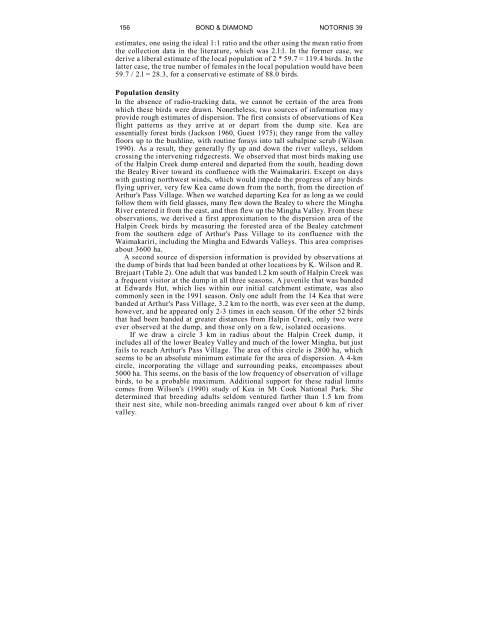NOTORNIS - Kea Conservation Trust
NOTORNIS - Kea Conservation Trust
NOTORNIS - Kea Conservation Trust
Create successful ePaper yourself
Turn your PDF publications into a flip-book with our unique Google optimized e-Paper software.
156 BOND & DIAMOND <strong>NOTORNIS</strong> 39<br />
estimates, one using the ideal 1:1 ratio and the other using the mean ratio from<br />
the collection data in the literature, which was 2.l:l. In the former case, we<br />
derive a liberal estimate of the local population of 2 * 59.7 = 119.4 birds. In the<br />
latter case, the true number of females in the local population would have been<br />
59.7 / 2.l = 28.3, for a conservative estimate of 88.0 birds.<br />
Population density<br />
In the absence of radio-tracking data, we cannot be certain of the area from<br />
which these birds were drawn. Nonetheless, two sources of information may<br />
provide rough estimates of dispersion. The first consists of observations of <strong>Kea</strong><br />
flight patterns as they arrive at or depart from the dump site. <strong>Kea</strong> are<br />
essentially forest birds (Jackson 1960, Guest 1975); they range from the valley<br />
floors up to the bushline, with routine forays into tall subalpine scrub (Wilson<br />
1990). As a result, they generally fly up and down the river valleys, seldom<br />
crossing the intervening ridgecrests. We observed that most birds making use<br />
of the Halpin Creek dump entered and departed from the south, heading down<br />
the Bealey River toward its confluence with the Waimakariri. Except on days<br />
with gusting northwest winds, which would impede the progress of any birds<br />
flying upriver, very few <strong>Kea</strong> came down from the north, from the direction of<br />
Arthur's Pass Village. When we watched departing <strong>Kea</strong> for as long as we could<br />
follow them with field glasses, many flew down the Bealey to where the Mingha<br />
River entered it from the east, and then flew up the Mingha Valley. From these<br />
observations, we derived a first approximation to the dispersion area of the<br />
Halpin Creek birds by measuring the forested area of the Bealey catchment<br />
from the southern edge of Arthur's Pass Village to its confluence with the<br />
Waimakariri, including the Mingha and Edwards Valleys. This area comprises<br />
about 3600 ha.<br />
A second source of dispersion information is provided by observations at<br />
the dump of birds that had been banded at other locations by K. Wilson and R.<br />
Brejaart (Table 2). One adult that was banded l.2 km south of Halpin Creek was<br />
a frequent visitor at the dump in all three seasons. A juvenile that was banded<br />
at Edwards Hut, which lies within our initial catchment estimate, was also<br />
commonly seen in the 1991 season. Only one adult from the 14 <strong>Kea</strong> that were<br />
banded at Arthur's Pass Village, 3.2 km to the north, was ever seen at the dump,<br />
however, and he appeared only 2-3 times in each season. Of the other 52 birds<br />
that had been banded at greater distances from Halpin Creek, only two were<br />
ever observed at the dump, and those only on a few, isolated occasions.<br />
If we draw a circle 3 km in radius about the Halpin Creek dump, it<br />
includes all of the lower Bealey Valley and much of the lower Mingha, but just<br />
fails to reach Arthur's Pass Village. The area of this circle is 2800 ha, which<br />
seems to be an absolute minimum estimate for the area of dispersion. A 4-km<br />
circle, incorporating the village and surrounding peaks, encompasses about<br />
5000 ha. This seems, on the basis of the low frequency of observation of village<br />
birds, to be a probable maximum. Additional support for these radial limits<br />
comes from Wilson's (1990) study of <strong>Kea</strong> in Mt Cook National Park. She<br />
determined that breeding adults seldom ventured farther than 1.5 km from<br />
their nest site, while non-breeding animals ranged over about 6 km of river<br />
valley.












